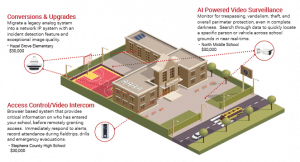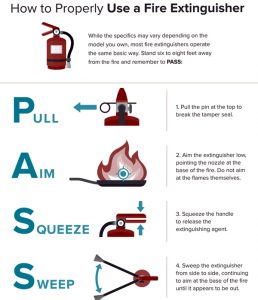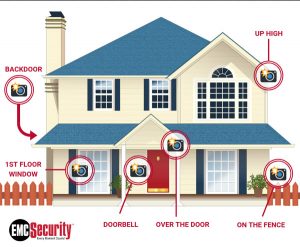Your cart is currently empty!
Month: February 2020
-

How to Spend Your School Security Grant
In 2019, the Georgia Board of Education awarded all public and charter schools with a security grant of $30,000 for security upgrades. The June 30, 2020 deadline for utilizing the $30,000 Safety Grant is fast approaching.
EMC Security is helping many schools determine the best use of the funds, and implementing security plans customized for their needs.
As a premier school security provider, EMC Security currently protects over 350,000 students across 18 county school districts in North Georgia.
The most effective campus security solutions are video surveillance and access control.
These solutions are effective measures for deterring a crisis and responding to emergencies in an education environment.
Examples of school upgrades:
Conversions & Upgrades: Migrate a legacy analog system into a network IP system with an incident detection feature and exceptional image quality. – Hazel Grove Elementary
AI Powered Video Surveillance: Monitor for trespassing, vandalism, theft, and overall perimeter protection, even in complete darkness. Search through data to quickly locate a specific person or vehicle across school grounds in near real-time. – North Middle School
Access Control/Video Intercom: Browser based system that provides critical information on who has entered your school, before remotely granting access. Immediately respond to alerts, record attendance during field-trips, drills and emergency evacuations. – Stephens County High School
EMC Security is your single source for end-to-end solutions and service. Protecting over 350,000 students across 18 school districts in Georgia, EMC Security provides customized solutions for dozens of facilities within their $30,000 grant budget.
- Scalable solutions. Non-proprietary equipment designed for future expansion.
- On-time. Deadline for installation is June 30, 2020.
- Within budget. High quality service with competitive rates well within the grant’s parameters.
- 120-day payment terms. Zero down payment to assist with up-front costs.
School Administrator Testimonials
Josh Fincher; Director of Plant Operations; Washington Wilkes BOE
“I was very pleased with the quality of workmanship of EMC Security. The crew went above and beyond to make sure that our project was as minimally invasive and went as smoothly as possible. I can’t stress enough how grateful I am for EMC Security’s customer service and attention to detail throughout the project.”
Brad Richardson; Purchasing Coordinator; Forsyth County Schools
“After struggling through one defaulted contractor, we received prompt and professional service provided by EMC. Their service actually exceeded the expectations as we discovered that the process and methodologies that they employ were more advanced that we had anticipated the market offering.”
Daniel W. Jardine; Chief Operations Officer; Gwinnett County Schools
“The service and support delivered to Gwinnett County Public Schools by EMC Security has met and exceeded our expectations since 2009. We have made significant improvements in our facilities monitoring and response capabilities as a direct result of the technical expertise they provide.“
Call Daniel Homrich at 770-807-9661 to schedule a free 20-minute on-site school evaluation and consultation.
-

What to Put in an Emergency Kit
In addition to protecting your loved ones with a security system, it’s a good idea to consider how to protect them from other unexpected incidents such as natural disasters.
The best way to prepare for a massive power outage (most often caused by a natural disaster) is to build an emergency kit.
Here’s how:
Consider how many people (and animals) your survival kit will need to support and what their specific needs are. For example, what kind of emergency are you expecting? Does the emergency typically require you to stay in place (at home) or would you possibly need to evacuate? If you think there’s an evacuation possibility, you may want to consider creating a portable survival kit that you can easily throw in your car.
The Essentials for an Emergency Kit
Water: You don’t want to get caught without a clean water supply. Plan on having at least one gallon of water on hand per person per day, for drinking, bathing, and cleaning. You can purchase gallons of purified water at a grocery store or reuse empty juice bottles and fill them with tap water.
Food: When an emergency shuts down the power grid, it also shuts down most grocery stores and restaurants. Be prepared with energy bars, beef jerky, nuts, and dried fruit. You can also add a can opener and include canned foods like soup and vegetables. Don’t forget baby food and pet food if needed. For easy clean-up, include paper plates and plastic-ware.
Information and Light: During a disaster situation, you can’t rely on local news, internet, and mobile phones for updates and information. We suggest adding a weather radio to your kit to stay informed of changes in weather, evacuations, and other important information. Many weather radios also include lights and cellphone chargers, reducing the number of electronics you’ll have to keep in your kit.
It’s also important to also have batteries and flashlights handy.
First Aid: Your emergency kit should include a variety of first aid items such as bandages, gauze, antibiotic ointment, and pain medications. You can also include items like burn cream, elastic bandages, allergy medicine, tourniquets, and other first aid items. Experts suggest putting items in waterproof containers so they stay dry and ready to use.
Shelter and Clothing: Every emergency kit should include at least one extra set of clothes and a blanket for each person. It’s also a good idea to include a waterproof tarp if you need to camp out in the elements.
Comfort and Cleanliness: While it may be low priority, you can’t underestimate the reassuring effects of cleanliness and comfort when you’re under stress. Include personal hygiene items, baby wipes, and garbage bags on hand to keep everyone feeling their best and to avoid sickness that can come from unsanitary conditions.
Important Documents: While it’s not necessary to include these items before an emergency strikes, it’s a good idea to throw them in if and when you have to evacuate.
- Insurance
- Passports
- Birth certificates
- Cash
- Other documents necessary
Tips:
- Plan for a minimum of three days of survival.
- Store your kit in a large water-proof storage tub is a good option for most kits. It keeps everything in one place and it’s fairly easy to move if you have to evacuate. For mobile and smaller kits, use a in case you have to grab essentials from your kit and go.
- Store your kit in a climate-controlled environment (so food doesn’t spoil) where you can access it easily.
Learn more at ready.gov.
-

View Crime Incidents in Your Neighborhood with SpotCrime
Are you moving into a new neighborhood? Do you want to keep informed of crime in your city? Look no further than SpotCrime.com to help.What is SpotCrime?
SpotCrime is a public facing crime map and crime alert service. With SpotCrime, it’s easier than ever to check crime anywhere in the United States and many other countries worldwide.
You can easily look up city and county crime data and reports — all the way down to local neighborhood statistics. The daily crime maps shows crime in your city down to the neighborhood, zip code, or street level.
Is SpotCrime free?
SpotCrime is a free service. Their mission is to encourage public trust, increase police transparency, and promote public safety.
What types of crime do they report?
- Arrests
- Arson
- Assault
- Burglary
- Robbery
- Shooting
- Theft
- Vandalism
- Other
How does SpotCrime work?
Relevant crime data is collected from police agencies and validated sources, plotted on a Google map, and compiled into crime alerts.
How do I search a location?
Simply type in an address or location at the top of the homepage. You can also subscribe to alerts.

Another cool feature:
Click on “Submit a Crime Tip” to enter information you want to submit about a potential crime. It will be sent to appropriate authorities.
Don’t forget to check out the SpotCrime blog for tips and relevant information.
Protect yourself further with a security system for your home or business – from just $179. EMC Security’s alarm monitoring starts at just $16.95 with no contract.
-

Living With Roommates – Safely
Today, more people are living in shared housing arrangements than ever before.
Nearly 79 million adults live in a shared household—that’s almost 32% of all adults in America.
Whether you’re living with roommates for fun or necessity, you have specific security needs when you share your home with others. You may want to protect your room, limit access to certain cupboards or drawers, or add the extra protection of a home security system.
Below are tips to navigate the roommate situation safely:
Before You Move In – Before You Sign the Lease.
1. Conduct a Background Check
If you’re taking applications for a new roommate, make background checks part of the process. And you don’t have to sweat the cost if you include it as part of an application fee.
On the flip side, if you’re looking at moving into someone’s home, you should know that you’re not moving in with a closeted serial killer. Ask the person advertising for a roommate if they’ll let you run a background check on them.
2. Get Some References
In addition to or if you can’t get a background check, checking references are a good idea. references help you know that you can trust the people you’re going to share a home with.
If you’re the one renting out a room, ask for references from previous landlords, roommates, or even their employer. You want to know that this person is reliable, respectful, and is going to make rent payments on time.
If you’re looking to move into a roommate situation, ask for references from the people already living in the home.
Living With Roommates
1. Set boundaries. Meet with your roommates and agree on ground rules for respecting personal property and space. Agree on communal areas and how to treat private spaces.
2. Put a lock on your door. Because you’re renting, you want a lock that you can install easily, without causing damage.
3. Use a personal safe. If you’re worried about adding a lock to your door, a safe is a good alternative to protect jewelry, electronics, and other valuables.
4. Get renters insurance. This may already be a requirement of your lease, but if it’s not, you should get it anyway. Renters insurance can help cover the cost of replacing lost valuables, whether it’s a roommate or a stranger that swipes something.
Tips for Securing Your Home When You Live with Roommates
1. Upgrade your door locks. Smart locks are perfect for renters because it fits over your existing deadbolt. It’s easy to install, and it has an app that every roommate can access.
2. When roommates move out, retrieve all keys, security codes, and other access information before they move out. If you use electronic locks or shared security apps, go in and change all the codes, usernames, and passwords.
3. Set-up a home security system. EMC Security offers a simple, unobtrusive home security that you can install on your own to make your house or apartment more secure.
4. For maximum protection, add security cameras both inside and out. You’ll be notified on your mobile phone if something is detected. EMC Security has options that are affordable and easy to install.
-
Before You Buy a Security System – Watch This Video
Want to learn more about the security system that’s right for you before you make a decision?
Contact us at 770-963-0305 and we’ll answer any questions you have.
-
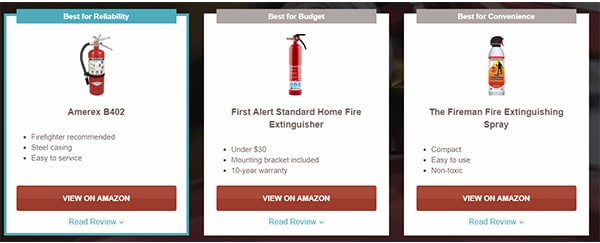
The Best Fire Extinguisher – and How to Use It
Every Moment Counts. Especially when there’s a fire. Criminals are selective about what they take, but a fire takes it all. It’s important to have the proper equipment in your home to protect yourself and your loved once should a fire occur.
The independent review site, Safewise.com, interviewed fire-fighters to determine which fire extinguisher they’d recommend.
Their pick: Amerex B402.
Amerex B402 is one of the most recommended fire extinguishers on the market, and its steel casing and aluminum valves make it durable enough to withstand a fire and be recharged for future use.
Other top contenders:
- First Alert Standard Home Fire Extinguisher: Best for Budget
- The Fireman Fire Extinguishing Spray: Best for Convenience
- First Alert Tundra Spray: Portable Pick
- Kidde ABC Multipurpose Fire Extinguisher: Disposable Pick
Types of Fires Extinguishers & Ratings
Before you purchase a fire extinguisher, it’s important to understand the different types of fires. Chemical fire extinguishers are filled with different fire suppressants, and choosing a type of extinguisher with the wrong contents could actually make a fire worse (like throwing water on a grease fire).
Household fires fall under three classifications, depending on the type of fuel burning. The most common fire extinguisher classifications are A, B, C, and K. Class A-B-C fire extinguishers will handle most household fires, but just to be on the safe side, it’s smart to also have a K-rated fire extinguisher on hand for your kitchen.
- Class A: Solid combustible materials that are not metals, like wood, paper, cloth, plastics, and rubber.
- Class B: Flammable liquids, like gasoline, oil, grease, and paints.
- Class C: Electrical equipment, like appliances and outlets.
- Class K: Cooking oils and greases, animal fats, and vegetable fats.
Where to Store Your Fire Extinguisher
It is best to store your extinguisher in your kitchen, 5–8 feet from potential fire sources like deep fat fryers, fireplaces, or clothes dryers. This way you can access them quickly and safely in case of a fire.
Make sure that there is always a fire extinguisher no farther than 40 feet away from any location in your home.
While it’s very important to have a fire extinguisher readily available in your home, it’s equally important to have smoke detectors installed. EMC Security recommends installing at least one monitored smoke detector outside the bedrooms. This way, if there’s a fire, we’ll work to get you the help you need, while you can concentrate on getting your loved ones to safety.
EMC Security monitors for fire at no additional monthly cost.
-
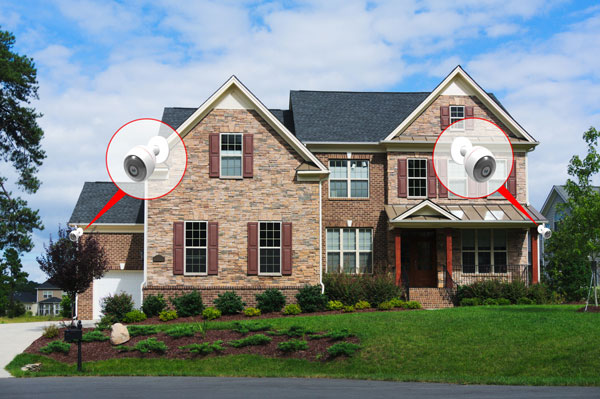
Safety at Home – Starting Outside
While examining safety in and around your house, don’t neglect safety measures on the outside of your house – to prevent an intrusion before it becomes reality.
Below are a few ideas for securing the outside of your home:
Pool Gates and Alarms
People with pools have a big responsibility to make them safe. It’s easier now more than ever before to keep your pool protected, while protecting your loved ones from accidents. Motion sensors and gate sensors, and cameras are the best ways to monitor activity in and around the pool. Call EMC Security for your options.
Motion Sensor Lights
Outdoor motion lights are extremely popular because not only do they light your way when letting your pet outside, taking out the trash, or parking in your driveway, they also light up the yard if someone is creeping around.
Smart Locks
Ever leave the house and forget to lock the door or can’t remember if you did? Smart locks let you lock up from an app on your smart device. If you have kids who come home from school before you do, or frequent pet or baby sitters, look into smart locks to make your life easier. Smart locks also keep a log of when doors were opened, so you can see if anything out-of-the-norm is happening at your house.
Security Cameras
If someone is creeping around your property, you’ll want to know about it. That’s why security cameras are an awesome addition to any home. Install one on the porch to monitor packages and mail deliveries, and several around the perimeter to keep an eye out for criminal activity. One common misconception is to hide the cameras. In reality, stats show if a thief spots a security camera, they will most likely move on to another target. You want everyone to know if they trespass, they will be caught on video.
Video Doorbells
Video doorbells are a fantastic addition to your home. They are in fact the most popular type of security camera on the market. They function as a live streaming video with two-way voice and a surveillance camera. If someone can’t get in, you can physically see them at your house and decide whether or not to let them in. And if any criminal activity ever does happen, you’ll have it stored on the cloud.
-

How to Dispose of Hazardous Waste
Most homeowners accumulate, over the years at least a few things are going to require special methods of disposal. Unlike your basic toss-outs or recyclables, hazardous waste can be harmful to people, animals, and the environment if not disposed of properly, making it extra important to get rid of these sorts of materials the right way.
Below are a few tips regarding how to dispose of hazardous waste safely.
What items are considered to be household hazardous waste?
You’d be surprised to learn that you probably have a lot of these substances in your home already.
- Combustible and flammable materials. Substances that ignite and burn easily.
- Spare cans of gasoline
- Propane tanks
- Oxidizers
- Liquid with a flashpoint of less than 140 degrees Fahrenheit.
- Corrosive materials. Substances—usually liquid—that can corrode metal.
- All industrial strength cleaners
- Items that contain common strong acids such as hydrochloric acid or sulfuric acid – like drain cleaners
- Reactive materials. Substances that are unstable and prone to possible explosion.
- Aerosol cans
- Toxic materials. Substances that can be seriously harmful or even deadly upon contact, consumption, or inhalation.
- Paint
- Antifreeze
- Motor oil
- Weed killers
How to dispose of hazardous waste
- Research the laws of hazardous waste disposal where you live. Different counties have different rules, so read up on them before you do anything else. Simply search “how to dispose of hazardous waste” + “[your county]” to see what comes up.
- Read the product labels. Many household hazardous materials come with general directions about how to (and how not to) store and handle them.
- Schedule a home pick up. Contact your local waste management company and ask them if they offer home pick ups for hazardous materials. Many do, though you may incur a fee.
- If they don’t do home pick-ups, your local waste management authority might be able to recommend drop off services.
- Many waste management facilities are hazardous waste mail-in recycling kits. These kits are especially useful if you live in an area without home pick-up services. With the mail-in service, the company will mail you a special container to put your hazardous items into. Then you just mail it back. This is useful for properly disposing of used batteries, fluorescent bulbs, and printer cartridges—all of which cannot be simply thrown in the trash or recycling bin.
- Donate. If you can, try to donate your hazardous materials to somebody else who needs them. If you have leftover paint, for example, you may be able to donate it to Habitat for Humanity or a charity that is remodeling their facilities. And your local nursery may be able to put your extra fertilizer to use, while the auto garage can possibly take leftover motor oil.
Other tips for disposing of hazardous materials
- Keep materials in their original packaging. Certain hazardous materials pose a heightened threat when exposed to air or when moved into another type of container than they came in, so always stay on the safe side and leave these types of substances in their original containers.
- Handle empty containers with care. Chemical residue on the insides of containers can pose a hazard even after the material itself is gone. If you have empty hazardous waste containers, they’ll have to be disposed of just as carefully as if they still had product in them.
- Combustible and flammable materials. Substances that ignite and burn easily.



